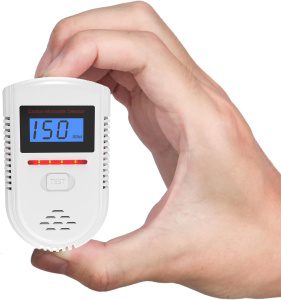Having a carbon monoxide detector is a no brainer especially if you have a wood burning stove in your tent or are using gas appliances such as heaters.
There’s a myth that carbon monoxide alarms should be installed lower on the wall because carbon monoxide is heavier than air. In fact, carbon monoxide is slightly lighter than air and diffuses evenly throughout the room.
According to the carbon monoxide guidelines of the National Fire Protection Association (NFPA 720, 2005 edition), all carbon monoxide alarms “shall be centrally located outside of each separate sleeping area in the immediate vicinity of the bedrooms,” and each alarm “shall be located on the wall, ceiling or other location as specified in the installation instructions that accompany the unit.”
Why CO alarms are often installed near the floor
Standalone carbon monoxide alarms are often placed low on the wall because they need to be plugged into an outlet that’s near the floor. CO alarms can also have a screen that shows the CO level and needs to be at a height where it’s easy to read.
Why you shouldn’t install a CO alarm near heating or cooking appliances
Also keep in mind not to install carbon monoxide detectors directly above or beside fuel-burning appliances, as appliances may emit a small amount of carbon monoxide upon start-up. A carbon monoxide detector should not be placed within fifteen feet of heating or cooking appliances or in or near very humid areas such as bathrooms.





